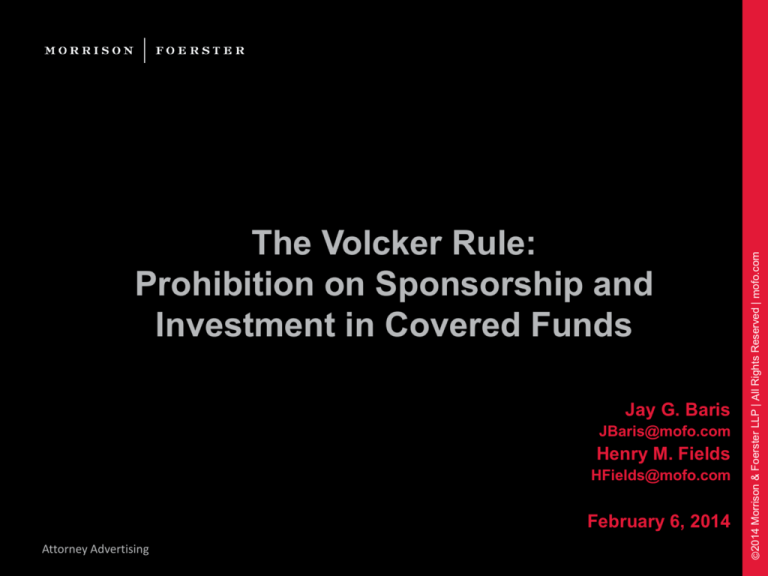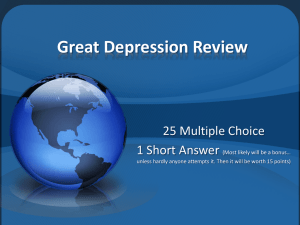
Jay G. Baris
JBaris@mofo.com
Henry M. Fields
HFields@mofo.com
February 6, 2014
Attorney Advertising
©2014 Morrison & Foerster LLP | All Rights Reserved | mofo.com
The Volcker Rule:
Prohibition on Sponsorship and
Investment in Covered Funds
Caveat
• This presentation is for informational purposes only and does not
constitute legal advice or create an attorney-client relationship
• Please consult your own attorney for legal advice on the issues
discussed in this presentation
• Because of the generality of this presentation, the information
provided may not apply in all situations and should not be acted upon
without specific legal advice based on particular situations
• This outline may constitute attorney advertising
2
The Volcker Rule
• The “Volcker Rule” is the popular name of Section 619 of the DoddFrank Act (DFA), enacted in July 2010
• Codified as Section 13 of the Bank Holding Company Act
• Section 619 of the DFA prohibits (with exceptions) banking entities
from
• Engaging in proprietary trading
• Sponsoring or investing (or retaining an interest in) private equity and hedge
funds
3
The Volcker Rule
• The statute is broad
• Congress left regulators to construe it without much specific direction
• October 2011: First proposed rules
• Rule proposals drew comments, including from international banking community
• December 10, 2013: Final Rule
• Effective April 1, 2014
• 71 pages
• 900-page preamble
4
Conformance Period
• The Volcker Rule took effect by statute on July 21, 2012
• Provides for a two-year conformance period, ending July 21, 2014
• Conformance period recently extended one year by Federal Reserve to July 21,
2015
• Each banking entity expected to make good faith efforts to conform
by end of conformance period
• New capital commitments likely prohibited
• Develop plan for disposition or restructuring of existing prohibited investments
• Capital calls under existing commitments
5
Conformance Period
• Two one-year extensions possible, upon application
• Further extension of up to five years available, upon application, for
continued investment/activity with respect to an “illiquid fund”
• To qualify for “illiquid fund” extension, must demonstrate that
retention of interest necessary to fulfill a contractual commitment in
effect on May 1, 2010
• Condition not met if a “regulatory-out” allows sale or redemption of interest
• Banking entity required to make reasonable best efforts to get consent for sale or
redemption, and to have that consent denied
• No expansion of impermissible activities or investments during the
conformance period with expectation of extensions
6
What the Volcker Rule Covers
• Banking entities include
• US banks and thrifts
• Bank and thrift holding companies
• Foreign banking organizations (FBOs) that operate a branch or agency or
commercial lending company in the US
• Affiliates of these entities
• Banking entities do not include
• A covered fund (unless it is a banking entity included in one of the first three
categories above)
• A portfolio company held by a financial holding company under merchant banking
authority or insurance company authority, and a portfolio company held by a
Small Business Investment Company (SBIC) (unless it is a banking entity
included in one of the first three categories above)
7
Covered Funds Prohibition
• General prohibition
• A banking entity, as principal, may not directly or indirectly acquire or retain an
ownership interest in, or sponsor, a covered fund
• The prohibition on acquiring or retaining ownership interests does not
apply if
• The banking entity acts solely as agent, broker or custodian for the account of, or
on behalf, of a customer and does not have its own ownership interest
• The banking entity’s ownership interest is held/controlled by it as trustee in
connection with a deferred compensation or similar plan
• The ownership interest is acquired and held in the ordinary course of collecting a
debt
• The banking entity holds the interest as a trustee or in a similar capacity solely for
a customer that is not itself a covered fund
8
Scope of Prohibition
• A banking entity may not sponsor a covered fund, subject to certain
exceptions
• Sponsorship means
• To serve as a general partner, managing member, trustee or commodity pool
operator (CPO) of a covered fund
• To select or control selection of a majority of directors, trustees or management
of a covered fund
• To share with the covered fund the same name or a variation of the name
9
Scope of Prohibition
• A banking entity may not acquire/retain an ownership interest in a
covered fund, subject to certain exceptions
• Ownership interest
• Means any equity, partnership or “other similar interest”
• “Other similar interest” is broadly defined to include
• An interest in or security issued by a covered fund that exhibits certain
characteristics on a current, future or contingency basis
• The right to participate in the selection/removal of general partner, or
managing member, director, investment manager or adviser (but not including
typical creditor’s rights in the event of a default or acceleration)
• The right to receive a share of income, gains or profits, or the underlying
assets (e.g., the “residual” in a securitization)
• Does not include “restricted profit interest” (carried interest)
• Ownership interest may include interests in a covered fund not
considered an ownership or equity interest in other contexts
10
Scope of Prohibition
• Ownership interests in securitization vehicles
• Many collateralized loan obligations (CLOs) and collateralized debt obligations
(CDOs) provide rights to a “controlling class” of senior debt security holders to
participate in the designation of investment managers or advisers
• As a result, holders of even the most senior, highly rated debt securities may be
considered to hold ownership interests
• If the securitization vehicle is a covered fund, a debt holder may inadvertently be
covered by the Volcker Rule
• CDOs holding trust preferred securities (TruPS) issued by certain issuers recently
have been specially exempted
• The exemption is narrow
• Review of this issue is at the “top of the list” for the Agencies
See our Client Alert: http://www.mofo.com/files/Uploads/Images/131226-Volcker-Rule-Impact.pdf
11
What Is a Covered Fund?
• Statute prohibits investment in and sponsorship of private equity and
hedge funds (not defined)
• Under the Final Rule, a “covered fund” includes an issuer that would
be an “investment company” under the Investment Company Act of
1940 (1940 Act) but for Section 3(c)(1) or Section 3(c)(7) of the 1940
Act
•
•
Section 3(c)(1) exempts from the definition of “investment company” funds
whose securities are sold privately to less than 100 purchasers
Section 3(c)(7) exempts from the definition of “investment company” funds
whose securities are sold privately only to “qualified purchasers”
• These two exemptions are the principal ones relied upon by private
equity and hedge funds, but many other investment companies rely
on these exemptions
• Concept imported from Title IV of the Dodd Frank Act, requiring
registration of investment advisers to private funds
12
What Is a Covered Fund?
• Commodity pools
• A commodity pool is a covered pool when the CPO has claimed an exemption
under Rule 4.7 under the Commodity Exchange Act (CEA)
• The CPO is registered in connection with the operation of a pool that limits
investors to qualified eligible persons (QEPs)
• “Exempt” commodity pools are covered funds because they have characteristics
similar to those of hedge funds or private equity funds
• They are restricted to investors that meet heightened qualification standards
13
What Is a Covered Fund?
• Foreign covered funds
• For a banking entity that is, or is controlled by, a US banking entity (which would
include a US branch/agency of a foreign bank), a covered fund includes a foreign
fund with the following characteristics
• The fund is organized outside the US
• The fund’s interests are offered and sold only to non-US persons
• The fund is sponsored by the US banking entity (or an affiliate)
• However, a foreign covered fund does not include a foreign fund that, if organized
or offered in the US, would not rely on Section 3(c)(1) or 3(c)(7) for an exemption
from the definition of an “investment company”
14
What Is Not a Covered Fund?
• Companies that do not meet the general definition of an “investment
company”
• For example, a fund may not be an investment company if it is not
engaged or proposes to engage in the business of investing in securities
that have a value exceeding 40% of the value of the company’s total
assets (excluding cash and government securities)
• Funds that rely on an exception other than those found in Section
3(c)(1) or Section 3(c)(7) of the 1940 Act
15
What Is Not a Covered Fund
• For a foreign banking entity (not controlled by a US banking entity), a
foreign private fund may not be a covered fund if
• The fund is organized under the laws of a foreign country; and
• The fund is offered and sold solely to non-US persons
• However, the breadth of this exclusion is not entirely clear
• Certain US connections to the fund may make the exclusion unavailable
• For this reason, it may be preferable for a foreign banking entity to
rely on the foreign fund exemption, which we discuss below
16
What Is Not a Covered Fund?
• A foreign public fund is not a covered fund if
• The fund is organized outside the US
• The fund is authorized to offer and sell its interests to retail investors in the fund’s
home jurisdiction (no investor suitability qualification)
• The fund sells its interests predominantly through one or more public offerings
outside the US (85% or more to non-US Persons)
• If a US banking entity sponsors the fund, the interests must be sold
predominantly to persons other than the sponsoring banking entity, its affiliates
and their employees and directors
• Foreign funds that do not meet the specific conditions of this
exclusion may not be covered funds for other reasons
• For example, they may qualify for the foreign fund exemption
(discussed below), or they may rely on exemptions other than
those found in Section 3(c)(1) or Section 3(c)(7) of the 1940 Act
17
What Is Not a Covered Fund?
• Loan securitization vehicles
• Loan securitization issuers may meet the definition of a covered fund if they rely
on Section 3(c)(1) or Section 3(c)(7) of the 1940 Act
• But the Volcker Rule was not intended to limit the ability of banking entities to sell
or securitize loans
• Thus, the definition of a “covered fund” explicitly excludes issuers of
collateralized obligations secured by loans (e.g., mortgage loans, auto loans,
student loans and credit card receivables), including commercial paper conduits
backed by loans
• However, there are detailed requirements for this exclusion, and securitization
vehicles with assets that include securities or derivatives may not qualify for the
exclusion and therefore are covered funds
• The treatment of securitization vehicles is complex
See our Client Alert: http://www.mofo.com/files/Uploads/Images/131226-Volcker-Rule-Impact.pdf
18
What Is Not a Covered Fund?
• Entities excluded from the definition of covered fund
•
•
•
•
•
•
Wholly owned subsidiaries
Joint ventures
Acquisition vehicles
Registered investment companies (including seeding vehicles)
Qualifying covered bonds
Other excluded entities
• Foreign pension or retirement funds
• Insurance company separate accounts
• Bank-owned life insurance company separate accounts
• SBICs and certain permissible public welfare and similar funds
• Entities used by the Federal Deposit Insurance Corporation (FDIC) to
dispose of assets as receiver or conservator
• Federal agencies will evaluate requests for more exclusions
19
What May or May Not Be a Covered Fund
• The federal agencies declined to exclude certain entities from the definition of
covered fund despite requests to do so
• In some cases, these are likely covered funds and in others not
• These entities include
• Financial market utilities
• Collateral cash pools
• Pass-through real estate investment trusts (REITs )
• Municipal securities tender option bond transactions
• Venture capital funds
• Credit funds
• Employee securities companies
20
Implications of Not Being a Covered Fund
• Why does it matter if a fund is a covered fund?
• If a fund is not a covered fund under these exclusions, the prohibitions on
sponsorship and investment do not apply and prudential backstops and the need
for a compliance program are not triggered, as discussed below
21
Permitted Activities and Investments
• Customer funds
• A banking entity may acquire ownership interests in, and/or sponsor, a covered
fund as a means of offering investment opportunities to its existing or future
customers
• This customer fund activity must be in connection with the banking entity’s trust,
fiduciary or investment management services for customers pursuant to a written
plan
• Detailed conditions apply
• Among other things, the banking entity
• Cannot guarantee performance of customer funds
• Cannot share the same name as a customer fund
• Must make clear and conspicuous specified disclosures in writing to prospective
investors
22
Permitted Activities and Investments
• Asset-backed securities
• A banking entity may acquire ownership interests in an issuing entity of assetbacked securities* that is a covered fund, but only in connection with the
banking entity’s organization and offering of the covered fund’s ownership
interests, subject, generally, to the same conditions that apply to customer
funds
• This exemption does not permit a banking entity to invest, as a passive investor, in
ownership interests in securitization vehicles that are covered funds
• Underwriting and market-making activities
• A banking entity may acquire an ownership interest in a covered fund in
connection with the banking entity’s underwriting or market making of the
covered fund’s ownership interests, as long as those activities conform to the
Volcker Rule’s requirements for permissible underwriting and market makingrelated activities
*See Securities and Exchange Act of 1934, §3(a)(79)
23
Investment Limitations
• Per-fund limits
• A banking entity’s and its affiliates’ investment in covered funds, as a general rule
cannot exceed 3% of the value of, or the number of ownership interests in, the
covered fund
• During a seeding period of up to one year, the investment may exceed the 3% limit
while unaffiliated investors are actively solicited
• Special rules apply for calculating the per-fund investment limits for ownership
interests held in
• asset-backed securities issuers in connection with a banking entity’s
organization and offering of that entity’s ownership interests and
• covered funds whose ownership interests are underwritten by a banking
entity or in which a banking entity makes a market
24
Investment Limitations
• Aggregate investment limits
• The aggregate value of all ownership interests in such permitted covered fund
investments cannot exceed 3% of the banking entity’s Tier 1 capital
• Capital deduction
• A US banking entity (but not an FBO) is required to deduct from Tier 1 capital its
investment in such funds
• The Volcker Rule treatment does not correspond to Basel III risk weights and
deductions for fund investments
• The Agencies intend to review the interaction between the Volcker Rule and
Basel III and propose steps to reconcile them
25
“Super 23A” and 23B Restrictions
• No banking entity that (i) advises or sponsors a covered fund, (ii)
organizes and offers a customer fund or an issuer of ABS, or (iii)
holds an ownership interest in an ABS issuer, and no affiliate of any
of these, may enter into any of the following transactions with the
fund*
• A loan or extension of credit to the fund (including repos)
• The purchase of securities issued by the fund (except for permitted ownership
interests)
• The purchase of assets from the fund
• The issuance of guarantees, acceptances or letters of credit on behalf of the fund
• Securities borrowing or lending or derivative transactions that result in the
banking entity having a credit exposure to the fund
*Section 23A also prohibits the acceptance of securities issued by an affiliate as collateral for a loan,
but as such a transaction would not be with the covered fund, it is not subject to Super 23A
26
“Super 23A” and 23B Restrictions
• These restrictions are called “Super 23A” because, unlike Section
23A itself, which allows affiliated transactions within limits, these
prohibitions are absolute
• However, the following transactions are permitted
• Acquisitions of ownership interests in a covered fund to the extent permitted
elsewhere in the Final Rule
• Subject to certain conditions, prime brokerage transactions ( transactions that
would be subject to Super 23A but are provided in connection with custody,
clearance and settlement, securities borrowing and lending, trade execution, etc.)
with a covered fund in which a covered fund that is managed, sponsored or
advised by the banking entity or its affiliates has taken an ownership interest (a
“second-tier fund”)
• The “market terms” requirement of Section 23B of the Federal
Reserve Act also applies, as if the banking entity were a bank and
the fund it sponsors or advises, its affiliate
27
Other Permitted Activities and Investments
• Risk-mitigating hedging activities
• Sponsorship of, and investment in, covered funds engaged in permitted riskmitigating hedging activities, subject to extensive conditions, including a specific
internal compliance program
• Insurance companies
• Investment and sponsorship by regulated foreign and domestic insurance
companies of any covered funds, if conducted in compliance with applicable
insurance investment laws
28
Other Permitted Activities and Investments
• Foreign fund exemption
• In addition to the exclusion from the definition of covered fund for certain foreign
funds, the Volcker Rule contains an exemption for a foreign covered fund
• To qualify for the foreign fund exemption, the investor/sponsor
• May not be a US banking entity or controlled by a US banking entity
• If an FBO, must be a qualified foreign banking organization (QFBO)
• If not an FBO, must be organized outside the US and have a majority of its business
outside the US
• Must make investment/sponsorship decisions outside the US—i.e., decision-making
personnel must be outside the US (back office and administrative functions can be in
the US, and investment advice can be given from the US)
29
Other Permitted Activities and Investments
• Additional conditions for foreign fund exemption
• Fund interests may be offered and sold only in an offering that does not target US
Persons (basically, compliant with SEC Regulation S, with appropriate
disclosures)
• Secondary trades?
• Fund investment/sponsorship (including any related hedging) cannot be booked
or accounted for in a US entity (including in any US branch/agency)
• No financing of any fund investment/sponsorship may be provided by a US
affiliate (including any US branch/agency)
• Prudential backstops apply
See http://www.mofo.com/files/Uploads/Images/131211-Volcker-Rule.pdf
30
Prudential Backstops
• No permitted fund investments and activities are permissible if
• The investment/activity involves or results in a material conflict of
interest between the banking entity and its clients, customers or
counterparties, unless
• The banking entity makes clear and timely disclosure of the conflict, or
• The banking entity uses information barriers, such as physical separation of personnel
or functions, that address the conflict
• The investment/activity results in a material exposure by the banking
entity to a high-risk asset or a high-risk trading strategy
• The investment/activity poses a safety and soundness threat to the
institution or a threat to US financial stability
31
Other Regulations Not Pre-empted
• None of the activities or investments permitted under the
Volcker Rule pre-empt other applicable investment or activity
limitations that apply to banking entities and their affiliates
• A banking entity must evaluate any such investment/activity under both the
Volcker Rule and other regulations of the Board of Governors of the Federal
Reserve applicable to investments and activities by banking entities and their
affiliates
• For example, a bank holding company may be able to hold 10% of a real estate
fund under the Volcker Rule
• However, the bank holding company may not be able to invest in more than
4.9% of the ownership interests of such a fund under other applicable
provisions of the Bank Holding Company Act
32
Compliance Programs
• The compliance program requirement applies to all banking entities
(including FBOs) engaged in proprietary trading or permitted covered
fund investment/activity
• If a banking entity is not engaged in proprietary trading (other than trading in US
government obligations) or covered fund investment/activity, it is not required to
establish a Volcker Rule-specific compliance program
• However, it will need to determine whether it is engaging in such activities
• Banking entities with such activities/investments that have total consolidated
assets of $10 billion or less need only refer to the requirements of the Volcker
Rule in their compliance policies and procedures and make “adjustments as
appropriate given the activities, size, scope and complexity of the [banking entity]”
33
Compliance Programs
• All other banking entities engaged in covered fund activity must
implement a compliance program that meets the following six criteria
• Written policies and procedures reasonably designed to document, describe,
monitor and limit proprietary trading activities, and activities and investments with
respect to covered fund activities, to ensure compliance with the Volcker Rule
• A system of internal controls reasonably designed to monitor compliance with the
Volcker Rule, and to prevent the occurrence of activities or investments that are
prohibited by the Rule
• A management framework that delineates responsibility and accountability for
compliance with the Volcker Rule and includes management review of trading
limits, strategies, etc.
• Independent testing and audits of the effectiveness of the compliance program
• Training for trading personnel and managers, as well as other “appropriate”
personnel, to appropriately implement and enforce the compliance program
• Records sufficient to demonstrate compliance with the Volcker Rule
34
About Morrison & Foerster
We are Morrison & Foerster—a global firm of exceptional
credentials. Our clients include some of the largest financial
institutions, investment banks, Fortune 100, technology and
life sciences companies. We’ve been included on The
American Lawyer’s A-List for 10 straight years, and Fortune
named us one of the “100 Best Companies to Work For.”
Our lawyers are committed to achieving innovative and
business-minded results for our clients, while preserving
the differences that make us stronger. This is MoFo. Visit
us at www.mofo.com.
© 2014 Morrison & Foerster LLP. All rights reserved.
La-1237842v6
35







